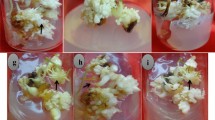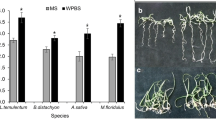Abstract
Incorporation of cupric sulfate into callus induction, maintenance, and regeneration media significantly enhanced plant regeneration from callus cultures of barley (Hordeum vulgare L.) immature embryos. Embryos from the cultivars ‘Hector’ and ‘Excel’ were cultured on MS medium containing 0, 0.1 (MS level), 0.5, 1.0, 5.0, 10.0, 50.0, or 100.0 μM cupric sulfate. Plants were regenerated beginning at 8 weeks and continuing through 36 weeks. For Hector, medium containing 50 μM copper regenerated significantly more plants than any other medium, with an average of 17 plants per embryo. In comparison, medium with MS copper levels (0.1 μM) regenerated only 5 plants per embryo. For Excel, medium containing 5.0 μM copper was the best, regenerating 1.4 plants per embryo. No Excel regenerants were obtained on medium with MS copper levels. Increased copper levels also increased the percentage of embryos that regenerated at least one plant, in both cultivars. The results indicate that MS copper levels are not optimized for barley callus cultures, and that improved plant regeneration can be obtained at higher copper concentrations.
Similar content being viewed by others
Abbreviations
- MS:
-
Murashige & Skoog (1962)
- 2,4-d :
-
2,4-dichlorophenoxyacetic acid
References
Baillie AMR, Rossnagel BG & Kartha KK (1993) Evaluation of 10 Canadian barley (Hordeum vulgare L.) cultivars for tissue culture response. Can. J. Plant Sci. 73: 171–174
Bregitzer P (1992) Plant regeneration and callus type in barley: effects of genotype and culture medium. Crop Sci. 32: 1108–1112
Ghaemi M, Sarrafi A & Alibert G (1994) The effects of silver nitrate, colchicine, cupric sulfate and genotype on the production of embryoids from anthers of tetraploid wheat (Triticum turgidum). Plant Cell Tiss. Org. Cult. 36: 355–359
Goldstein CS & Kronstad WE (1986) Tissue culture and plant regeneration from immature embryo explants of barley, Hordeum vulgare. Theor. Appl. Genet. 71: 631–636
Luhrs R & Lorz H (1987) Plant regeneration in vitro from embryogenic cultures of spring- and winter-type barley (Hordeum vulgare L.) varieties. Theor. Appl. Genet. 75: 16–25
Murashige T & Skoog F (1962) A revised medium for rapid growth and bioassays with tobacco tissue cultures. Physiol. Plant. 15: 473–497
Purnhauser L (1991) Stimulation of shoot and root regeneration in wheat Triticum aestivum callus cultures by copper. Cereal Res. Comm. 19: 419–423
Purnhauser L & Gyulai G (1993) Effect of copper on shoot and root regeneration in wheat, triticale, rape and tobacco tissue cultures. Plant Cell Tiss. Org. Cult. 35: 131–139
Wan Y & Lemaux PG (1994) Generation of large numbers of independently transformed fertile barley plants. Plant Physiol. 104: 37–48
Author information
Authors and Affiliations
Additional information
The US Government's right to retain a non-exclusive royalty-free license on and to any copyright is acknowledged
Rights and permissions
About this article
Cite this article
Dahleen, L.S. Improved plant regeneration from barley callus cultures by increased copper levels. Plant Cell Tiss Organ Cult 43, 267–269 (1995). https://doi.org/10.1007/BF00039954
Received:
Accepted:
Issue Date:
DOI: https://doi.org/10.1007/BF00039954




